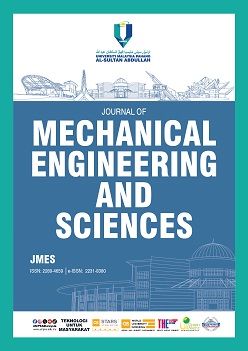Effect of internal partition on a naturally cross-ventilated generic building using computational fluid dynamics
DOI:
https://doi.org/10.15282/jmes.18.4.2024.5.0811Keywords:
computational fluid dynamics, natural ventilation, internal obstacles, dimensionless flow rateAbstract
This research focuses on investigating the characteristic of natural ventilation for an isolated building particularly on the air velocity and flow rate. It involves a numerical analysis using computational fluid dynamics for a generic building configuration with internal obstacles and under natural ventilation conditions. Internal obstacles within the building were modeled as internal partition walls with varying widths. Five different external opening configurations were considered: top-top, middle-middle, bottom-bottom, top-bottom and bottom-top. Atmospheric boundary layer conditions were imposed at the inlet plane and the 3-D Steady Reynolds Averaged Navier Stokes equations were solved with the Standard k-ε model coupled with enhanced wall treatment. Results show that the highest dimensionless flow rate (DFR) is recorded at 0.568 for the top-top opening position without obstacle, while it is also observed that the varying internal obstacles have substantial impact to the DFR. Hence, it could be concluded that ignoring the effects of partition walls or internal obstacles in the study of natural ventilation can underestimate the DFR by as much as 11.2% as compared to an empty building setup. The study is able to provide useful information on the airflow characteristics for the natural ventilation application in the building sector.
References
[1] N. R. M. Sakiyama, L. Mazzaferro, J. C. Carlo, T. Bejat, H. Garrecht, “Natural ventilation potential from weather analyses and building simulation,” Energy and Buildings, vol. 231, p. 110596, 2021.
[2] Y. Jiang, D. Alexander, H. Jenkins, R. Arthur, Q. Chen, “Natural ventilation in buildings: Measurement in a wind tunnel and numerical simulation with Large-Eddy simulation,” Journal of Wind Engineering and Industrial Aerodynamics, vol. 91, no. 3, pp. 331–353, 2003.
[3] H. Shetabivash, “Investigation of opening position and shape on the natural cross ventilation,” Energy Building, vol. 93, pp. 1–15, 2015.
[4] L. K. Moey, Y. H. Sing, V. C. Tai, T. F. Go, Y. Y. Sia, “Effect of opening size on wind-driven cross ventilation,” International Journal of Integrated Engineering, vol. 13, no. 6, pp. 99–108, 2021.
[5] H. Sacht, M. A. Lukiantchuki, “Windows size and the performance of natural ventilation,” Procedia Engineering, vol. 196, pp. 972–979, 2017.
[6] T. S. Larsen, P. Heiselberg, “Single-sided natural ventilation driven by wind pressure and temperature difference,” Energy and Buildings, vol. 40, no. 6, pp. 1031–1040, 2008.
[7] K. Kosutova, T. Van Hooff, B. Blocken, J. Hensen, “CFD analysis of ventilative cooling in a generic isolated building equipped with ventilation louvers,” in Healthy Buildings Europe, Eindhoven, Netherlands, 2015.
[8] K. Kosutova, T. Van Hooff, C. Vanderwel, B. Blocken, J. Hensen, “Cross-ventilation in a generic isolated building equipped with louvers: Wind-tunnel experiments and CFD simulations,” Building and Environment, vol. 154, pp. 263–280, 2019.
[9] P. Karava, T. Stathopoulos, A. K. Athienitis, “Airflow assessment in cross-ventilated buildings with operable façade elements,” Building and Environment, vol. 46, no. 1, pp. 266–279, 2011.
[10] N. F. M. Kasim, S. A. Zaki, M. S. M. Ali, N. Ikegaya, A. A. Razak, “Computational study on the influence of different opening position on wind-induced natural ventilation in urban building of cubical array,” Procedia Engineering, vol. 169, pp. 256–263, 2016.
[11] Y. Tominaga, B. Blocken, “Wind tunnel analysis of flow and dispersion in cross-ventilated isolated buildings: Impact of opening positions,” Journal of Wind Engineering and Industrial Aerodynamics, vol. 155, pp. 74–88, 2016.
[12] R. Ramponi, B. Blocken, “CFD simulation of cross-ventilation for a generic isolated building: Impact of computational parameters,” Building and Environment, vol. 53, pp. 34–48, 2012.
[13] B. Blocken, “50 years of computational wind engineering: Past, present and future,” Journal of Wind Engineering and Industrial Aerodynamics, vol. 129, pp. 69–102, 2014.
[14] T. Van Hooff, B. Blocken, Y. Tominaga, “On the accuracy of CFD simulations of cross-ventilation flows for a generic isolated building: Comparison of RANS, LES and experiments,” Building and Environment, vol. 114, pp. 148–165, 2017.
[15] Y. Tominaga, B. Blocken, “Wind tunnel experiments on cross-ventilation flow of a generic building with contaminant dispersion in unsheltered and sheltered conditions,” Building and Environment, vol. 92, pp. 452–461, 2015.
[16] P. H. Nimarshana, R. A. Attalage, K. K. C. Perera, “Quantification of the impact of RANS turbulence models on airflow distribution in horizontal planes of a generic building under cross-ventilation for prediction of indoor thermal comfort,” Journal of Building Engineering, vol. 52, p. 104409, 2022.
[17] C. R. Chu, Y. H. Chiu, Y. W. Wang, “An experimental study of wind-driven cross ventilation in partitioned buildings,” Energy and Buildings, vol. 42, no. 5, pp. 667–673, 2010.
[18] C. R. Chu, B. F. Chiang, “Wind-driven cross ventilation with internal obstacles,” Energy and Buildings, vol. 67, pp. 201–209, 2013.
[19] B. Blocken, T. Stathopoulos, J. Carmeliet, “CFD simulation of the atmospheric boundary layer: Wall function problems,” Atmospheric Environment, vol. 41, no. 2, pp. 238–252, 2007.
[20] Y. Tominaga, A. Mochida, R. Yoshie, H. Kataoka, T. Nozu, M. Yoshikawa, et al., “AIJ guidelines for practical applications of CFD to pedestrian wind environment around buildings,” Journal of Wind Engineering and Industrial Aerodynamics, vol. 96, no. 10–11, pp. 1749–1761, 2008.
[21] B. Blocken, “Computational fluid dynamics for urban physics: Importance, scales, possibilities, limitations and ten tips and tricks towards accurate and reliable simulations,” Building and Environment, vol. 91, pp. 219–245, 2015.
[22] J. Franke, C. Hirsch, G. Jensen, H. W. Krus, S. D. Miles, M. Schatzmann, et al., “Recommendations on the use of CFD in wind engineering,” in COST Action C14, Impact of Wind and Storm on City Life and Built Environment, 2004.
[23] T. Van Hooff, B. Blocken, “Coupled urban wind flow and indoor natural ventilation modelling on a high-resolution grid: A case study for the Amsterdam Arena stadium,” Environmental Modelling Softwware, vol. 25, no. 1, pp. 51–65, 2010.
[24] L. K. Moey, K. L. Chan, V. C. Tai, T. F. Go, P. L. Chong, “Investigation on the effect of opening position across an isolated building for wind-driven cross ventilation,” Journal of Mechanical Engineering and Sciences, vol. 15, no. 2, pp. 8141–8152, 2021.
[25] K. Zore, B. Sasanapuri, G. Parkhi, A. Varghese, “Ansys mosaic poly-hexcore mesh for high-lift aircraft configuration,” in 21st Annual CFD Symposium, Bangalore, India, pp. 1–11, 2019.
[26] P. J. Richards, R. P. Hoxey, “Appropriate boundary conditions for computational wind engineering models using the k-ϵ turbulence model,” Journal of Wind Engineering and Industrial Aerodynamics, vol. 46, pp. 145–153, 1993.
[27] P. J. Roache, “Quantification of uncertainty in computational fluid dynamics,” Annual Review of Fluid Mechanics, vol. 29, no. 1, pp. 123–160, 1997.
Downloads
Published
Issue
Section
License
Copyright (c) 2024 The Author(s)

This work is licensed under a Creative Commons Attribution-NonCommercial 4.0 International License.






